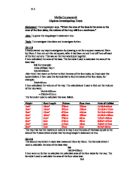Surface area to volume ratios of above cubes
Small cube 1: 6 large cube 1: 3
The smaller cube has a volume of 1 unit³ and surface area of 6 units², while the larger cube has a volume of 8 units³ and a surface area of 24 units², this is the same as each unit of volume having 3 units of surface area. In this example the larger cube has half the relative surface area. This means that the smaller cube can loose heat to its environment over a relatively greater area than can the larger cube.
The theory that the larger the object the better it retains heat can be observed in certain animals. One example is the emperor penguin and the fairy penguin. The emperor lives in Antarctica and is large and the Fairy lives in Australia and is small. As the emperor lives in a cold climate it needs to retain heat. This is achieved because the emperor has a low surface area : volume ratio which means it retains heat more efficiently. The fairy needs to lose heat as it lives in a hot climate. It achieves this by having a high surface area : volume ratio which means it loses heat more efficiently. Generally animals that live in cold regions tend to be bigger than related species that live in hot areas because they need to retain heat. In this experiment beakers were used, as it would be unethical to use animals.
Trial experiment:
In my trial experiment I used 50ml, 100ml beaker. I heated them up and time them over 5 mins.
Obtaining results
Equations:
πr² x 2 + h x c = surface area
100ml 39.27 109.95 149.225
250ml 66.37 183.78 250.15
600ml 113.49 333.79 447.28
1000ml 73.18 478.31 651.49
Ratios:
100ml: 1 : 1.5
250ml: 1: 1
600ml: 1: 0.75
1000ml: 1: 0.6
Analysing
From the Graph I can see a definite positive, linear correlation between the surface area and the decrease in temperature. So as the size of the beaker increased, its surface area relative to its volume decreased and the heat loss to the environment was less. By drawing a line of best fit it can be seen that the results do not significantly stray from the line. The line itself indicates that a doubling in the relative surface area doubles the rate of heat loss. There does not appear to be any anomalous data.
These results agree with my prediction. Heat is lost from an object to its environment through the surface area or the object, in this case glass beakers. Even though in a large beaker the actual total surface area is greater than in a small beaker, each unit of volume inside the beaker has on average less surface area in contact with the outside. So the heat from the water inside the small beaker will be lost faster because more of the water is closer to the surface and the distance that the heat has to travel to leave the beaker is shorter. This applies in living organisms as well. Small bodies lose heat more quickly than large ones, for instance young babies are more at risk of loosing too much heat compared to larger adults. Also smaller species of animal can also loose heat faster to their environment, so they might have designs that conserve heat better and they tend to have higher metabolic rates that larger species. This is because they need to respire faster, and respiration (in mammal and birds) produces heat, so if they are losing heat faster they need to produce it faster.
Evaluating
The graph above shows the averages for three repeat measurements, if you look at the three individual measurements you can see that there is no wide variation and so the averages are reliable. Over all I believe that my results were very reliable. They show a definite trend that I expected in my prediction. I carried out each test three times to get a reliable and accurate average. Also I carried out each experiment as accurately as I could, and measured and timed things very accurately. Also the fact that I do not have a single anomalous result shows that the experiment was carried out accurately.
To make my results more reliable I could have used more beakers and repeated the experiment more times to get a better average. Also I included the whole beaker to get the surface area, instead of the surface area of the beaker, which the volume of water touched. Maybe if I changed this I would get more accurate results, but I don’t think it would change my results significantly. Another simple improvement would be to use a greater range of beaker sizes and more sizes in between, eg 50ml, 500ml and even 2000ml beakers.
A different experiment I could do to show that it really is surface area, which is affecting the rate of heat loss and not the differences in levels up to which the fixed volume of water comes in the different sized beakers, would be to change the shape of the beakers. This would be to have containers of the same volume and made of the same material but which have different shapes. For example a short wide beaker and a tall narrow beaker, and in both we would put the same volume of water filling both containers completely. Objects of the same volume can have very different surface areas (see diagram below) .Then from this we could see whether it really is the surface area that affects heat loss from an object.
The surface area of the object below is 34 units with a volume of 8
While this object having the same volume has a smaller surface area of only 24 units.







